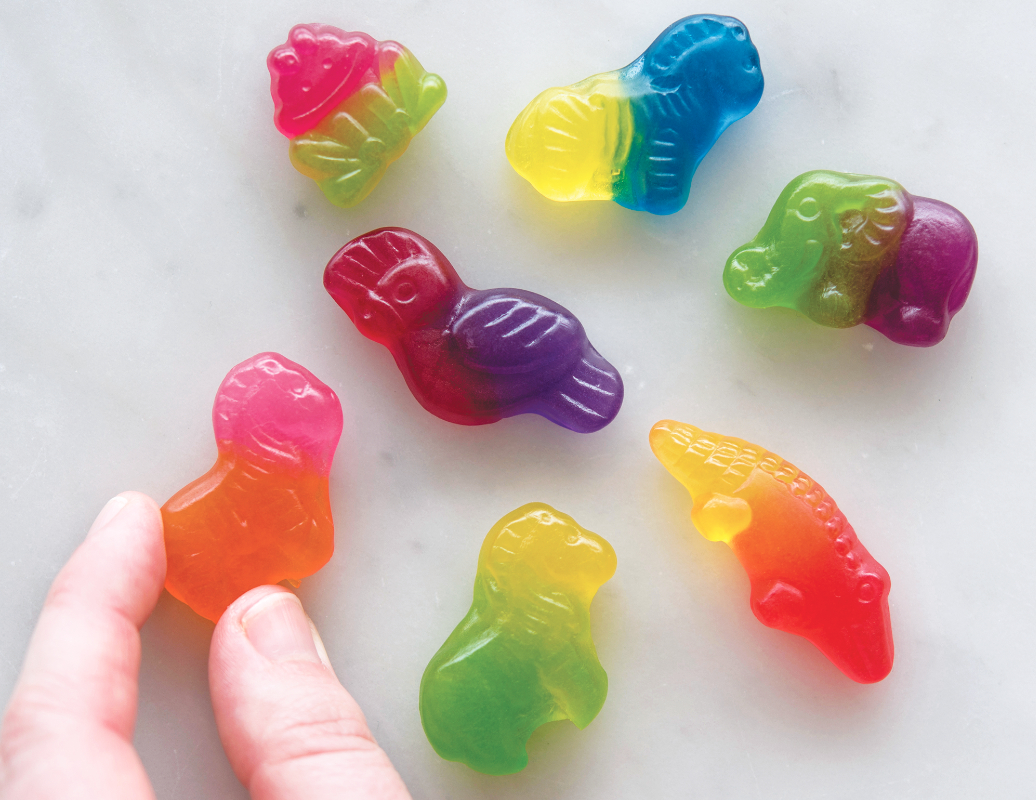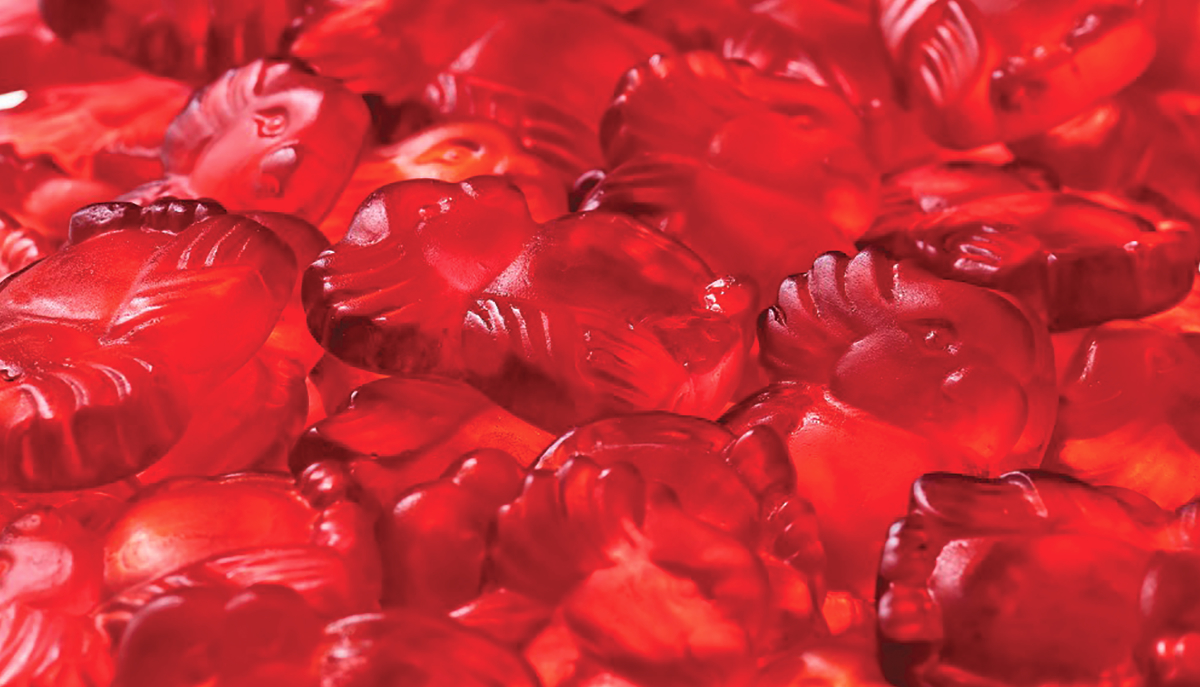KANSAS CITY — The opportunity to market clean label products has hit many categories, even confectionery. Coloring candy with natural sources, instead of FD&C colors in the United States or colors that require E numbers in Europe, is a prime example. Taking this approach will mean analyzing pH factors, finding solutions to achieving an acceptable red color and considering purple innovations.
“Naturally sourced colors, especially those made from recognizable ingredients such as fruit and vegetable juice concentrates, are better aligned with the feel-good quality inherent to indulgent treats,” said Jeannette O’Brien, vice-president/sales manager for GNT USA, Inc., Tarrytown, N.Y. “Consumers, especially parents, may feel better about buying a sweet or candy for their child if it includes colors from natural sources.”
Connie Sandusky, global marketing director, DDW, The Color House, Louisville, Ky., added, “Consumers want to understand the ingredient list on the food package. There is a certain comfort in reading a fruit or vegetable name vs. FD&C, an E number or something that sounds like it belongs in laundry detergent.”
Once companies decide to take a natural route in colors, pH comes into play.
Due to the sensitivities of different pigments, some naturally sourced colors may perform better in acidic systems while others are better in a neutral system, said Patricia Bonets, application scientist for Chr. Hansen, which has a U.S. office in Milwaukee.
“At a lower pH, acidic-type products like a jelly or a hard candy are easier to match using anthocyanins,” she said. “The anthocyanins can provide a range of shades from orange-red to purple and generally are more stable at low pH conditions and higher temperatures. However, blues and greens are more challenging in the lower pH systems. When you are working with a neutral pH, the opposite happens. The reds are more challenging, and the blues and greens become easier to work with.”
Red is difficult to produce naturally due to pH factors and interactions with other ingredients, said Phil Cook, research and development platform leader, colors at Diana Food, a Symrise business based in Hasbrouck Heights, N.J.
“When a producer is used to handling synthetic colors like Red 40 which ‘just work’ in most applications, it can be a shock for them to receive colors which are pink in one matrix, then purple in another,” he said.
Mr. Cook said Diana Food, by using purple carrot juice concentrate, offers three shades: a bright strawberry red, a bluer raspberry red and a grape/blackcurrant red.
The stability of blue and red remains a challenge, said Scott Ondracek, application scientist for DDW, The Color House.
“You can achieve a gorgeous blue color in a panned candy, for example, but forget it in a boiled sweet,” he said. “It’s exposed to too much heat. The perfect match to FD&C Red 40 in red velvet cake also remains elusive. Here both heat and the higher pH of typical chemical leavening agents have to be considered.”
Sweet baked foods will require a different coloring approach than hard candy.
“Synthetic colors like Red 40, Yellow 5, Green 3, Blue 1 and more still appear on ingredient legends, not just within the confectionery and sweet baked good categories, but also across the entire food and beverage industry,” said Chris Naese, vice-president of business development for Florida Food Products, Eustis, Fla. “Take a red velvet cake, for instance, which requires quite a bit of coloring to provide its characteristic deep red color. Baked goods companies that have traditionally relied on Red 40 to instill this color may now be exploring on-trend natural colorants such as beet juice or powder to meet their needs.”
Ms. O’Brien said beet works well at a higher pH, which makes it a better option for bakery items like red velvet cake and cupcakes.
In an example of color innovation for baked foods, Dawn Foods, Jackson, Mich., in April plans to launch Naturally Brilliant buttercremes and flat icings (for donuts) that are made from naturally sourced colors, said Elena Taylor, director — wet ingredients for Dawn Foods.
“Dawn plans to have solutions for red, blue, yellow, pink and lavender buttercremes and/or flat icings,” she said. “These colors show the greatest market potential for everyday buttercreme options, and they appeal to a wide array of consumers. We also wanted to expand into naturally colored flat icings and broaden our offerings in this category.”
Dawn Foods has partnered with Innova Market Insights to find trends in naturally sourced colors. Since 2013, new bakery products with naturally sourced colors have grown 14%. The use of carrot concentrate as a color has increased 25%, and the use of red beetroot juice concentrate as a color has increased more than 27%.

Purple options
Naturally sourced purple colors could rise in use, too.
“Purple is one of the most exciting and dynamic colors currently available to food and beverage manufacturers,” Ms. O’Brien said. “Purple shades can vary from lilac to deep royal purple depending on the pH and the fruit and vegetable source. We’ve been receiving a lot of requests for frozen desserts, fruit preps and jams, and confection. For these applications, we have a range of colors derived from our particular variety of purple carrot and purple sweet potato.”
Healthy Food Ingredients, Fargo, N.C., offers ways to create purple color through its Suntava Purple Corn, which has a high level of anthocyanins, said Terry Howell, Suntava Purple Corn ingredient expert for Healthy Food Ingredients.
“The versatility of the anthocyanins found in purple corn also enables product development specialists to create various shades of purple depending on a product’s pH level,” he said. “We have partnered with a well-known manufacturer to produce both a liquid and powdered purple color extract from the deeply colored kernels of our domestically produced Suntava Purple Corn. In addition, companies can create beautifully colored cereals, snacks, breads, muffins, crackers, pasta, etc., by incorporating our purple corn flour, meal, snack meal or grits into their finished products.”
Purple corn especially works well in replacing Red 40.
“The ability to adjust the color to various shades of red or purple depending on pH is highly appealing to R.&D. professionals,” Mr. Howell said. “Currently purple corn coloring is seeing great success as a natural alternative to Red 40 in confectionery, beverage, dairy (including ice cream and yogurt), desserts and other baked goods.”
The choice of caramel is one other example where clean label becomes a factor.
Sethness Products Co., based in Skokie, Ill., and a business of Roquette, is fielding customer requests for colors compliant with California’s Proposition 65 and colors that are Non-GMO Project verified, said Brian Sethness, executive vice-president, sales and marketing for Sethness Products Co.
Sethness Products Co. produces 13 Non-GMO Project verified caramel colors.
“These are more expensive offerings than our typical caramel colors, but consumers, especially on the West coast, like to see the ‘butterfly’ on product labels,” he said in reference to the Non-GMO Project logo. “Class 1 or plain caramel colors have become the fastest growing segment of caramel colors as they meet consumer demand for cleaner labels on the foods and beverages they consume. The drawback to Class 1s is that they can only reach a certain level of darkness, more of a light brown shade.”
---------------
Sweet potato-based color serves as carmine alternative
A red color sourced from sweet potatoes might sound more appealing than a red color sourced from insects. That is one reason why Chr. Hansen has commercialized the new Hansen sweet potato Ipomoea batatas. The color sourced from the sweet potato serves as a vibrant, natural red alternative to carmine, which is derived from insects.
“More than 10 years ago we discovered a promising pigment in a root vegetable’s tuber, but the plant’s pigment content was on the low side,” said Diana Dix, applications manager for Chr. Hansen. “We took this plant and embarked on a process of selective breeding using traditional, non-G.M.O. methods. As consumers move toward vegetarian and vegan food choices, the need for a carmine alternative has become more pressing. Our new FruitMax reds are based on the Hansen sweet potato and are bright, beautiful and stable. They’re 100% plant-based with no off-taste. They are minimally processed and suitable for a long list of products.”
Carolina Innovative Food Ingredients, Inc., Nashville, N.C., also offers color options sourced from sweet potatoes.
“Carolina Original, our nutrient-dense, domestically sourced cloudy sweet potato juice, delivers functional benefits, including natural sweetness and an orange/amber color,” said Paul Verderber, senior vice-president of sales. “For example, you could use Carolina Original in a sweet potato hamburger bun, naturally adding color, flavor and sweetness to really make the bun stand out from others on the shelf.”
Purple color is another possibility.
“Purple is a very appetizing color that can be difficult to achieve naturally,” Mr. Verderber said. “Accordingly, interest in our Carolina Purple sweet potato juice concentrate, which offers a natural solution for bold purple color, continues to grow.”





